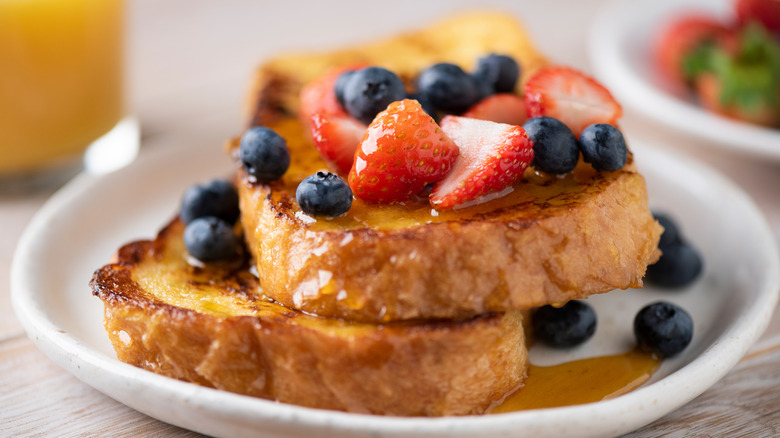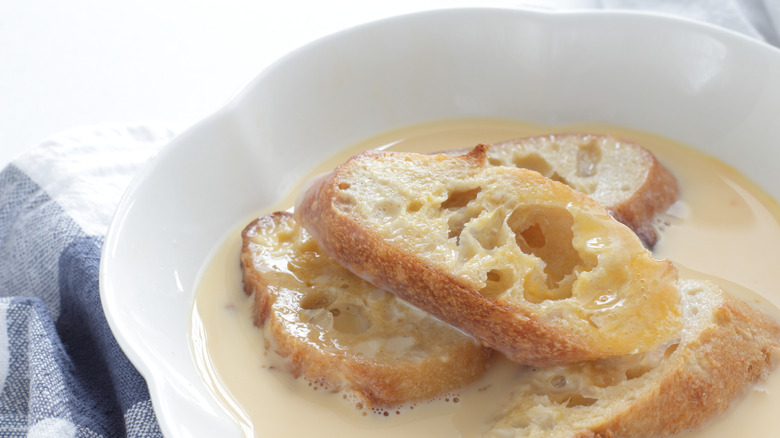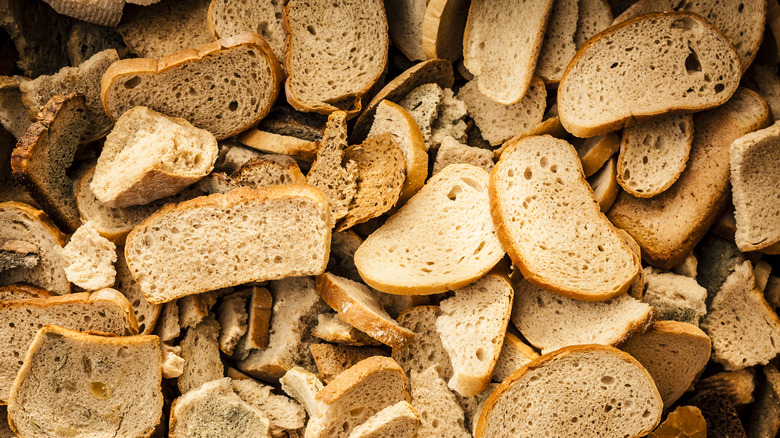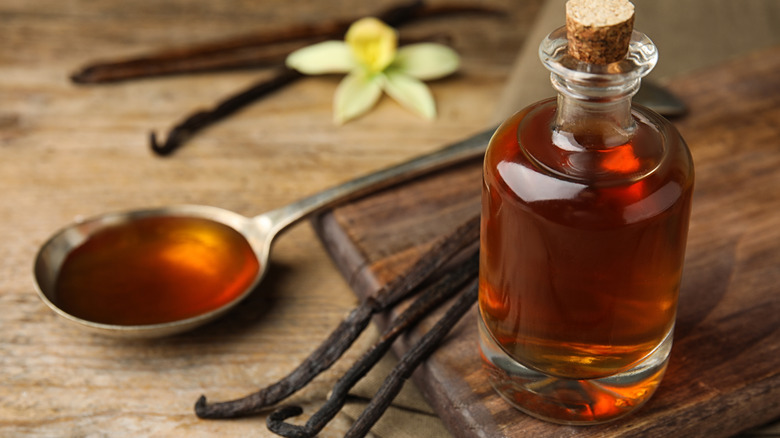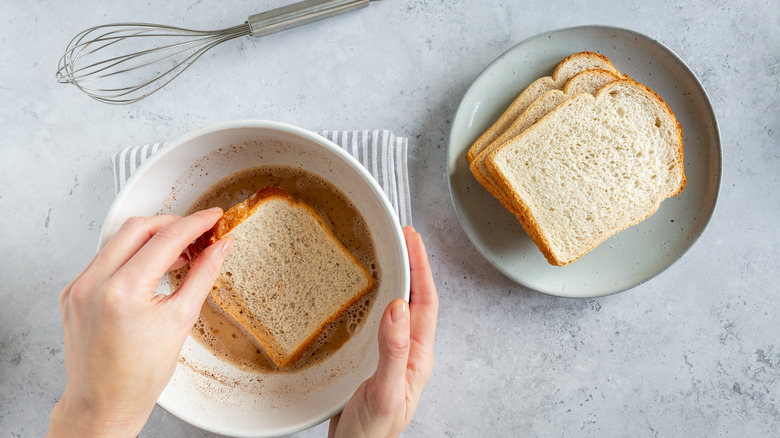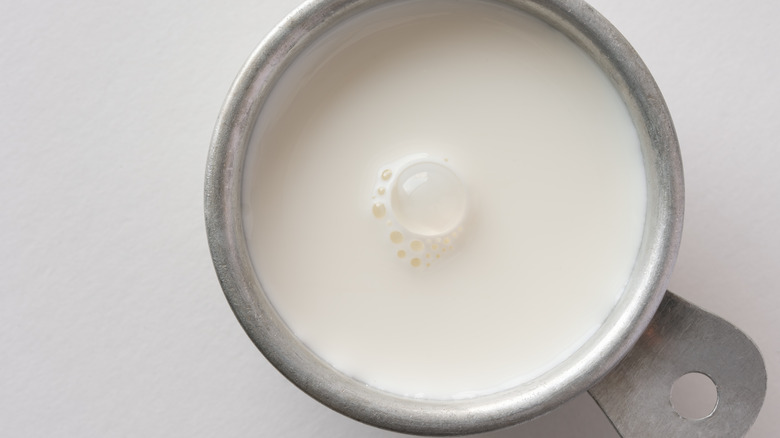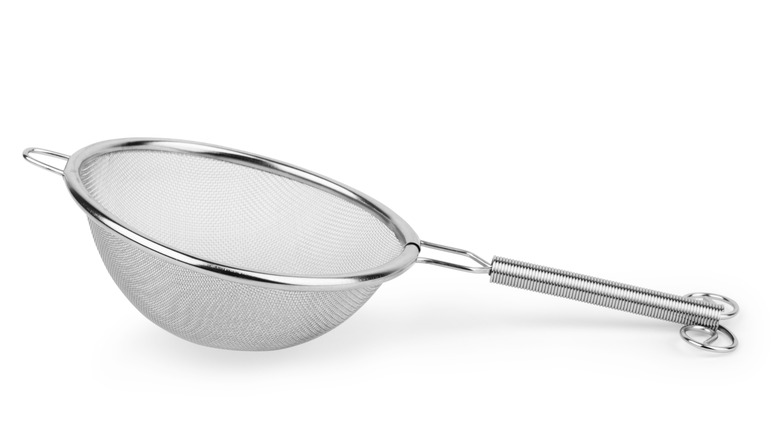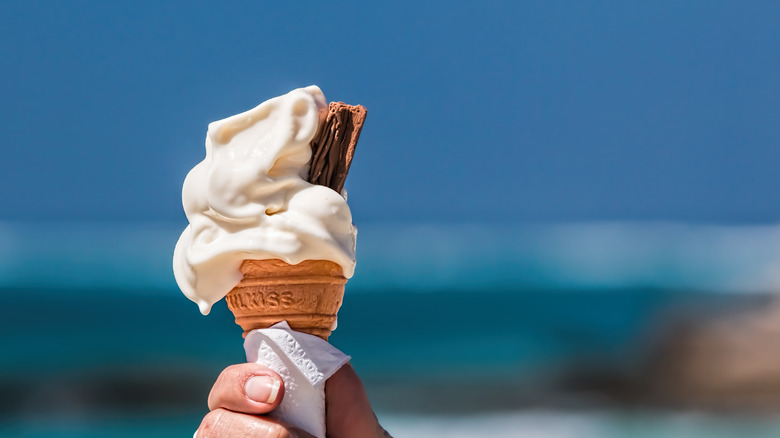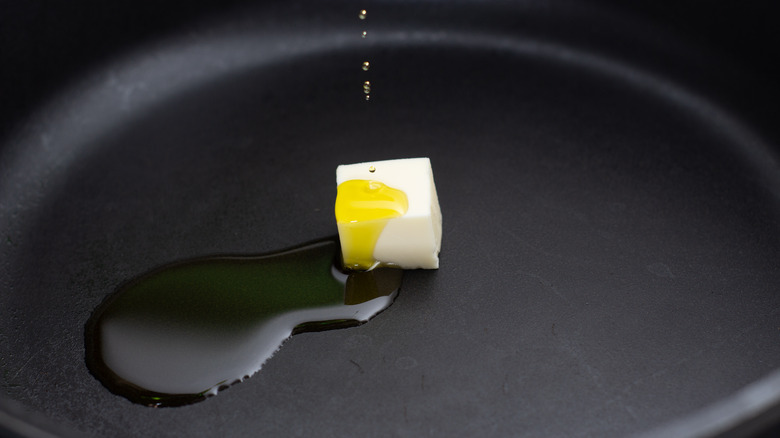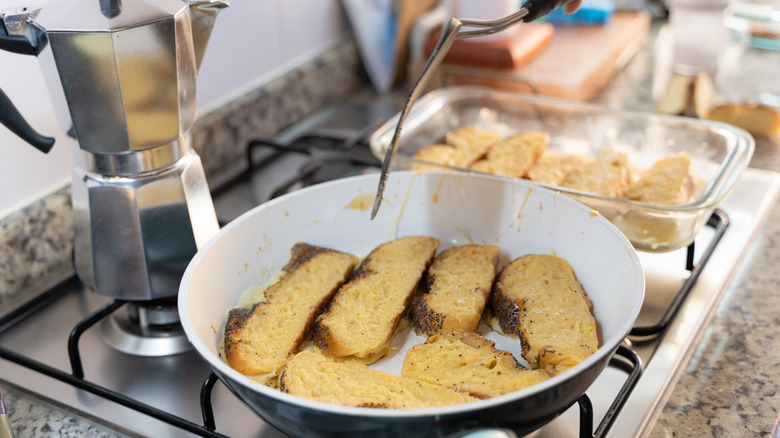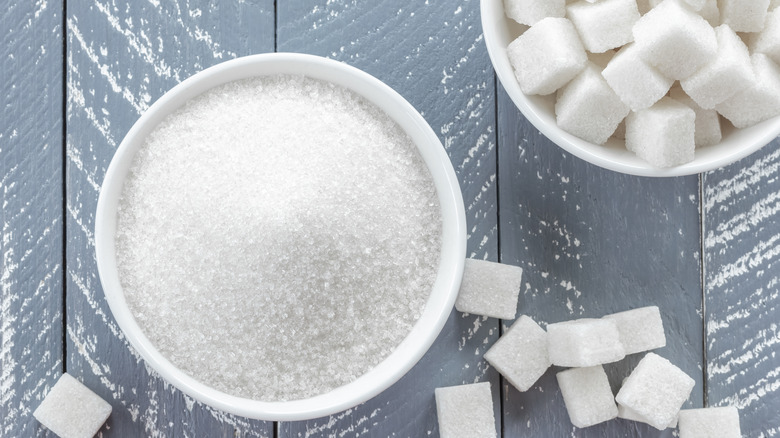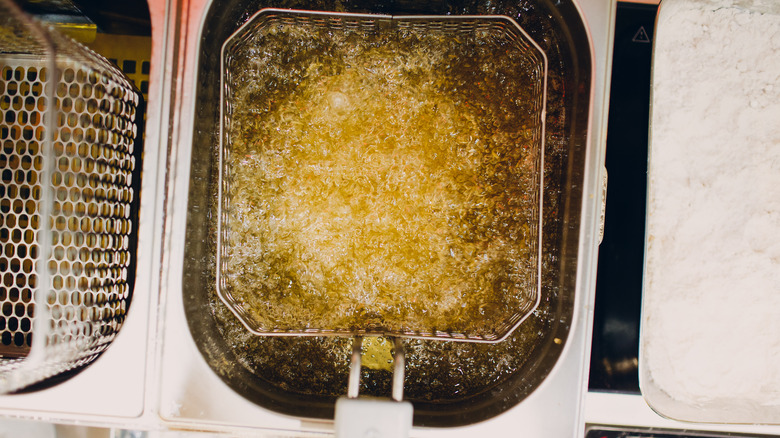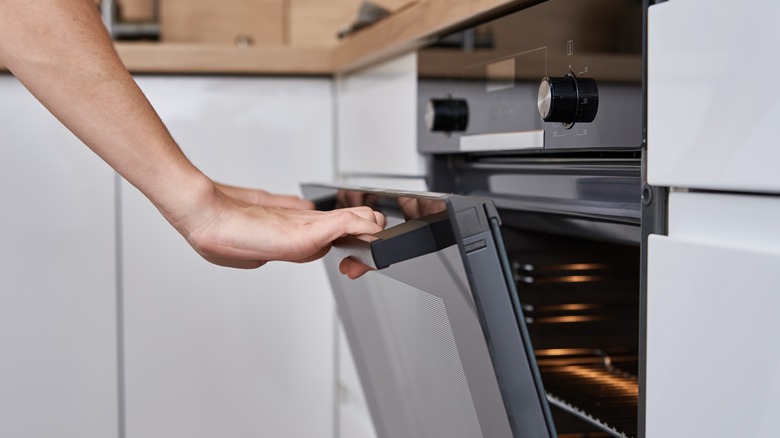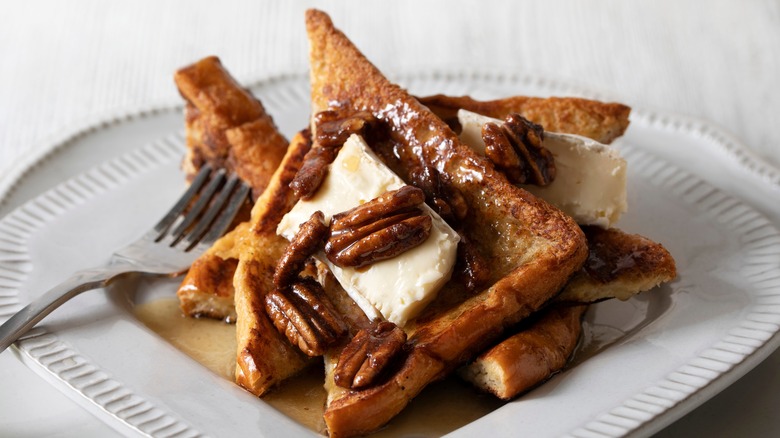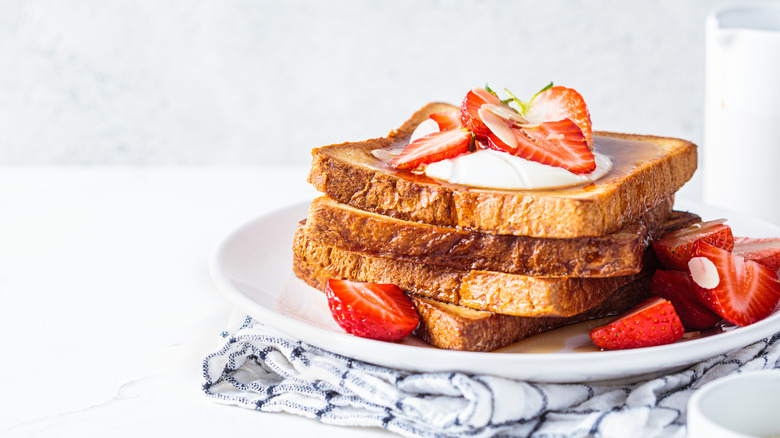15 Tips You Need For The Absolute Best French Toast
French toast deserves a rightful spot in the breakfast food hall of fame. We can thank the ancient Romans for the origins of the first French toast recipe. It appeared in one of the oldest cookbooks in the world, "Apicius," or "De Re Coquinaria," which advises home cooks to slice bread, take off the crust, soak in a mixture of eggs and milk, fry it, and serve it with honey. The recipe persisted until the Middle Ages as French "pain perdu," or "lost bread" — a title given to the dish because it could transform once "lost" stale bread into something delicious.
The recipe for French toast has since remained very similar to the Roman and French versions of the dish. Modern French toast includes bread slices that have been soaked in custard and cooked on a stovetop of a griddle. Other ingredients, like vanilla extract and sugar, have since come into play to help flavor the dish and amplify its dessert-like qualities. We've enlisted the help of John Currence, chef and founder of the Big Bad Breakfast restaurant group and author of "Big Bad Breakfast: The Most Important Book of the Day," to help you learn the secrets of making delicious French toast that would make the Romans jealous.
Venture into diverse types of bread
You need to make important considerations when selecting what type of bread to use for French toast. First, your bread must be sturdy enough to withstand the brief soak in the custard without denigrating; this is why many folks use stale bread for French toast. Chef Currence notes that you can use almost any type of bread to make French toast, including boule and baguette, or even more unconventional ingredients like donuts or croissants. Currence only recommends avoiding banana bread because he says "it's cake, not bread."
Use dense bread like challah or brioche if you want to stray from the standard white-or-wheat path. Both of these types of bread have a soft, buttery taste and thick, plush texture that makes them perfect for soaking in custard. You can also use flavored bread like cinnamon raisin or cinnamon swirl for a mildly sweet and richer taste that will elevate the flavor of your French toast. We recommend pairing the latter two types of bread with cinnamon apples and a scoop of your favorite whipped butter.
Another game-changing ingredient swap for French toast is to use shokupan — also known as Japanese milk bread — instead of another type of bread. Shokupan is much fluffier and dense than other sandwich bread, which means that it can soak up more of the custard than a dainty sandwich slice could.
Stuff your French toast
You may have seen stuffed French toast on the menu at a local breakfast joint and thought "that seems like it would be hard to make." But, in reality, making stuffed French toast only requires a couple of extra steps and a few special ingredients.
One of our favorite ingredients to stuff French toast with is fresh fruit. You can use everything from peaches to apples for a fruit-inspired breakfast treat. If you can't find fresh fruit, you can use canned fruit from your pantry — just remember that the canned varieties in syrup will be sweeter than fresh varieties. We also recommend pairing these fruits with a layer of cream cheese, chocolate spread, or peanut butter to help seal the bread and keep the fruit juices from soaking through.
To stuff your French toast, lay your slice flat with the crust removed. Next, use a rolling pin to flatten the bread before schmearing on your spread of choice. Spoon a row of fruit onto the bread and roll it to create a cylinder. Then, soak the bread in your egg mixture before transferring it to a frying pan or skillet — cooking it as you would regular French toast.
Always use dried bread
When it comes to the state of the bread you're using for your French toast, you need to think back to the pain perdu days. Dried bread will always be superior to fresh bread when it comes to French toast because dryness correlates to how much custard the bread can soak up — kind of like a dry sponge in water.
If you want to keep your French toast from getting soggy, you'll first want to start with dry or slightly stale bread. At the Big Bad Breakfast restaurants, Chef Currence's staff leaves sheet trays of bread, sliced between 1⅓ and 2 inches thick, out at the end of service the day before. This allows the bread to dry enough to make the perfect French toast.
If you only have fresh bread on hand, you can expedite drying by toasting the bread on the lowest setting in your toaster or toaster oven. The goal is not to get the bread golden brown but to remove some moisture so it can stand the 20-second soak without breaking apart. If you don't have a large enough toaster or toaster oven for the bread you need, you can place a row of sliced bread on a baking pan and run it on a low temperature (300 degrees Fahrenheit or less) for about 10 to 12 minutes until browned.
Use quality vanilla
The secret ingredient you should be using in your French toast — if you're not already — is vanilla extract. This ingredient increases the perceived sweetness of a dish and can add aroma to custards and baked goods. But, we should warn you that not all vanilla extracts are created equal.
The best vanilla extract brands are made with pure vanilla rather than petrochemical precursors found in artificial vanilla extracts. The aroma and flavor of pure vanilla are much more potent and complex than artificial vanilla, making it more desirable in a recipe like French toast. While you will pay more for pure vanilla extracts, you'll get a much more flavorful and desirable result. Our favorite brands of pure vanilla extract include Nielsen-Massey's selection of Madagascar, Tahitian, and Mexican extracts. The products also use cane sugar for better clarity and vanillin suspension. If you're on a budget, the McCormick pure vanilla extract is one of the cheapest and highest-quality extracts you can purchase.
Do a touch test to determine if your bread is soaked enough
Chef Currence notes there isn't an exact science behind how long you should leave your French toast in the custard. The thickness of the bread, its dryness, and the texture of the bread can all affect how the bread takes up moisture. Therefore, feeling the bread is the best way to determine if you can remove your French toast from the custard.
The chef recommends soaking the bread just long enough so that when you touch it, the bread will feel wet. "I dip and massage the bread with my fingers until I feel it's fully saturated but not falling apart," he notes. Thicker and crustier bread, such as state Italian or French country loaves, will float in the custard unless you press it down. Using your hands to manipulate the bread and pressing it down into the mixture allows the inside of the bread to soak up the custard, which will result in a more even cook and stable moisture throughout.
Try adding cream instead of milk
Fat, lactose, and protein are the reasons why milk is so important when making French toast. Together, these three components contribute to the Maillard reaction, which produces a caramel flavor when combined with heat. The milk also prevents the French toast from becoming too rubbery since the protein in the egg can quickly solidify and cause the toast to develop a rubbery barrier.
If you want more savory French toast with all of the chemical benefits of milk, you should substitute cream into the recipe instead. For more flavor, Alton Brown makes French toast using half-and-half instead of full-fat cream. Chef Currence seconds this, noting that choosing a higher-fat dairy product is all about the flavor. While he uses a 1-to-3 ratio of whole milk to eggs for most of his French toast recipes, he notes that using a higher-fat dairy product will mean you need even less dairy in the custard.
If saving custard, strain it first
Do you have to strain the custard before dipping your bread into it? Chef Currence says no because there's "nothing to strain." However, if he has enough custard left over from one service to another, he'll refrigerate it overnight and strain it before dipping the bread the next day. This helps remove any remaining bread particulates and helps keep the custard smooth.
To ensure that your custard is well-combined, we recommend using a fork or a whisk to beat air into it. You'll want to ensure that all the egg has been broken up and that the sugar, extracts, and cream are well combined. If you want a unique spin on French toast, you can try beating the egg whites and sugar separately until stiff peaks form. Then, stir it back into the remaining custard ingredients carefully to avoid squashing all the air out.
Soak the bread in ice cream
French toast is decadent on its own, but you can take your French toast to a whole new level with this easy switch. Instead of soaking your bread in a mixture of egg whites and milk, try soaking the bread in full-fat vanilla ice cream instead. Not only will you save a few ingredients, but you'll also find the breakfast's flavor much sweeter and full of soft vanilla notes.
Although this hack might seem outrageous at first glance, you have to consider that ice cream is made up of eggs, vanilla, and cream — the only additional ingredient is sugar. If you're going to opt for the ice cream hack, you'll first need to defrost your ice cream in the microwave first. You should always use thick, full-fat ice cream for the most unctuous texture and to keep your toast from cooking too quickly on the grill.
Don't neglect butter
What is the best fat to cook French toast in? "Butter, butter, butter," Chef Currence jokes. "Folks who are mixing butter and oil together in the pan are just doing it for healthy reasons." The butter will help crisp up the edges of the French toast and result in a perfect brown color. If you want a toastier and more caramel flavor, use brown butter instead.
Another potential cooking oil for French toast comes courtesy of another breakfast favorite: bacon. When Chef Currence cooks for his 10-year-old daughter, he first cooks bacon in the skillet. Then, after removing some of the bacon greases, he'll transfer his soaked bread into the pan and cook the French toast. "You'll get some of the bacon flavor and pick up some of those caramelized bacon bits," Currence shares. Plus, you'll reduce the number of pans you must clean after breakfast. It's a win-win.
Brown the bread on both sides
Like soaking the French toast, its cooking time will depend a lot on the thickness of the bread and how hot your flame is. If you're cooking a thick slice of loaf bread, it may take about three or four minutes on each side. "It's about the same time as cooking a pancake," chef Currence says, "but you don't have the bubbles this time." While these bubbles would indicate that the pancake is finished cooking, the French toast cook must rely on the texture and color of the toast to indicate doneness.
Besides a brown color on the toast, you can also use a finger test to see if your French toast is finished. Currence recommends touching the toast lightly; it should be firm to the touch if the egg has finished cooking rather than squishy. If you're worried about doneness, Currence's pro-tip is to cook the toast on the stovetop before transferring it to a 400-degree Fahrenheit oven to finish it.
Add sugar to your custard
Crunchy probably isn't the word that comes to mind when you think of a good plate of French toast the authentic French way, but it should be. Adding a bit of granulated sugar to your French toast while cooking will give you a crème brûlée crackle with a deep vanilla flavor. Once one side of your French toast is light brown, sprinkle half a tablespoon of granulated sugar on top of the bread. Then, flip the toast so it's sugar-side down. After that side has finished cooking, sprinkle more sugar and flip it back to the first side to complete the caramelization process.
Chef Currence notes there is always a risk of burning the toast if you cook it this way. If you're a sugar novice, he recommends adding a spoonful of sugar to the custard before dipping your bread in rather than adding it to the bread as it's cooking. He says you can also use a brûlée torch for even more control. We recommend this only if you know what you're doing, of course.
Deep fry your French toast for the best crunch
We never said French toast had to be healthy. Chef Currence recommends using a deep-fryer — rather than a griddle or a skillet — to make the most delicious French toast. He learned this trick at one of his old restaurants, where the griddle had become too overrun with pancakes, so there was no space to cook the French toast. Instead, his team cut the toast a little thicker, dropping it in the same custard and deep frying it for about three to four minutes. The texture of the French toast is akin to a donut with a crispier outside.
If you can deep fry French toast in a deep fryer, can you cook it in an air fryer? Yes, you can! Shake off the excess custard mixture and cook the French toast at 320 degrees Fahrenheit for three minutes on each side.
Use the oven to make a lot of French toast
French toast is one of the best breakfasts you can make for a brunch party or special celebration. But, the worst part about making French toast for a crowd is when you have to hover over your tiny griddle, which takes a lot of time for an entire loaf of bread. So, if you're looking for a quicker way to maximize your French toast-making experience, you should try cooking your toast in the oven.
To prepare your oven-baked French toast, you'll need to dip the slices of bread into the custard and place them on a rimmed baking sheet. Baking your French toast to perfect golden-brown doneness only takes about 15 minutes. The first 10 to 12 minutes should be cooked at normal baking temperature. Then, set your oven temperature to broil for the last two to three minutes to help achieve the perfect dark color.
Add a splash of alcohol to upgrade the flavor
Booze and French toast are a heavenly combination. Chef Currence frequently uses liquor like bourbon, brandy, and rum to elevate the flavors of his French toast. In most cases, he will combine a splash of vanilla extract to the custard with one of these alcoholic choices to help highlight the sweetness and flavor profile of the toast. Almond extract is one of his "secret ingredients" for a great plate of French toast. A tiny touch of almond extract gives the French toast "the flavor of wedding cake."
If you want to add alcohol to your French toast, add a splash to the custard. The alcohol will all cook off but leaves behind a delicious bourbon flavor, so you won't have to worry about serving your recipe to ABV-free folks. To integrate booze into your French toast topping, make a bourbon caramel sauce with maple syrup and bourbon. You can pour the sauce alone or add a sprinkle of pecans or walnuts.
Get creative with your flavors and toppings
Making French toast is a precarious balance of allowing the flavors of your toppings to shine through while keeping the simplicity of good French toast at bay. Chef Currence loves adding chopped fresh berries to French toast and the classic whipped cream topping. Adding a layer of powdered sugar to the top of French toast is common at most diners and breakfast restaurants. Currence also recommends adding a bit of cinnamon to the powdered sugar to make cinnamon French toast.
Currence's time in test kitchens has opened up the opportunity to work with unique ingredients that can elevate the flavor of French toast. He's experimented with cardamom and garam masala in the past and Chinese five spice. He says, "All of those things come to me because of my fascination with sweet and salty ... playing off sweet and salty flavorings works well in any dessert," — French toast included.
Static Media owns and operates Tasting Table and Mashed.
